 Imperial German Navy, Founded 1871 – c70 ships 1890.
Imperial German Navy, Founded 1871 – c70 ships 1890.
From the Unification to Whilhelm II
Towards the unification
The Kaiserliches Marine (Imperial Navy) was founded in 1870, right after the the Franco-Prussian war, immortalized in the Gallery of Mirrors of the Palace of Versailles near Paris, France. The Deutsche Einigung (unification) was the product of Chancellor Alfred Von Bismarck, really its main artisan. The result for the unification of all former Kingdoms, part of the old “Holy Roman Empire” made of Romanized Germanic peoples in medieval times and consolidated under the Habsburg rule. Since the 15th century the Empire’s Prince-electors had chosen alternated at the head of the House of Habsburg but only the Duchy of Austria held the title of “Holy Roman Emperor”. This fragmented state was convenient for France and Sweden. At the eve of the Napoleonic Wars this was a conglomerate of some 300 political entities, a few belobging to the Polish-Lithuanian Commonwealth or Hohenzollern Kingdom of Prussia, Swiss cantons. This “Kleinstaaterei” (small-statery) was deplored by early pan-German nationalists and early attempts of unifications had to wait for the Dissolution of the Old Empire provoked by the Napoleonic wars.
The Invasion of the Holy Roman Empire by the First French Empire (War of the Second Coalition) already in 1798 until 1802 caused a trauma not seen since the first under Louis XIV of France. Napoleon Bonaparte forced out by the treaty of Lunéville in 1801 and Mediatization of 1803 a greater integration by abolishing most free imperial cities to be integrated into dynastic states. Württemberg and Baden were the most favored by these acquisitions and were more lenient or even supportive of Napoleon. In 1806, the invasion of Prussia and its defeat at Jena-Auerstedt in 1806 (War of the Third Coalition) had its fate sealed by the Treaty of Pressburg which stated the formal dissolution of the Holy Roman Empire and abdication of Emperor Francis II. The “Confederation of the Rhine” became instead a French client state, which authority was still divided between a hundred petty princes and counts as well as imperial knights with Several states promoted to kingdoms such as Bavaria, Saxony and Hanover. Francis II remained solely Emperor of Austria from 1804.
Still, there was a rapid rise of German nationalism under Napoleon from 1804 to 1814. The German philosopher Johann Gottlieb Fichte stated:
The first, original, and truly natural boundaries of states are beyond doubt their internal boundaries. Those who speak the same language are joined to each other by a multitude of invisible bonds by nature herself, long before any human art begins; they understand each other and have the power of continuing to make themselves understood more and more clearly; they belong together and are by nature one and an inseparable whole.

Long story short, the defeat of Russia encouraged many Germans to envision a Central Europe free of Napoleon’s influence and many student militias were created, such as the Lützow Free Corps, forming the basis for an insurrection. Napoleon’s 1813 campaign in the German states was returned as a War of Liberation ending in the great Battle of Leipzig (Battle of Nations). It was probably the largest, bloodiest of the entire Napoleonic wars, but ended as decisive defeat for Napoleon, leading to its abdication and exile to Elba, later return for the “100 days” until the decisive defeat of Waterloo, in which the late intervention of Blücher and its battered but still eager Prussian army, turned the tides.
The German unification was a complex and transformative process which occurred over several decades, culminating in 1871 with the proclamation of the German Empire. The Napoleonic Wars profoundly affected the German states with the dissolution of the Holy Roman Empire in 1806 and giving a sense of pan-german nationalism to former populations that shared the same culture and language.
The Congress of Vienna (1814-1815) After Napoleon’s defeat redrawn the map of Europe to restore stability and established the German Confederation made of 39 consolidated German states under the leadership of Austria as was the former Holy German Empire.
The Zollverein (Customs Union) was an Economic integration that played a crucial role in German unification. Established in 1834, it removed internal tariffs facilitated trade among member states, fostering economic cooperation and a sense of unity.
The Revolutionary Movements of 1848-1849 (spring of nations) that swept across Europe, saw the German states fueled by demands for liberal reforms, constitutional government, and national unity ultimately failing to achieve their goals but powerfully contributed to the growth of nationalist sentiment.
The Prussian Leadership became a driving force behind German unification, under the leadership of Otto von Bismarck and King Wilhelm I. Bismarck’s Realpolitik, characterized by pragmatic diplomacy and calculated use of military force, aimed to strengthen Prussia and marginalize Austria.
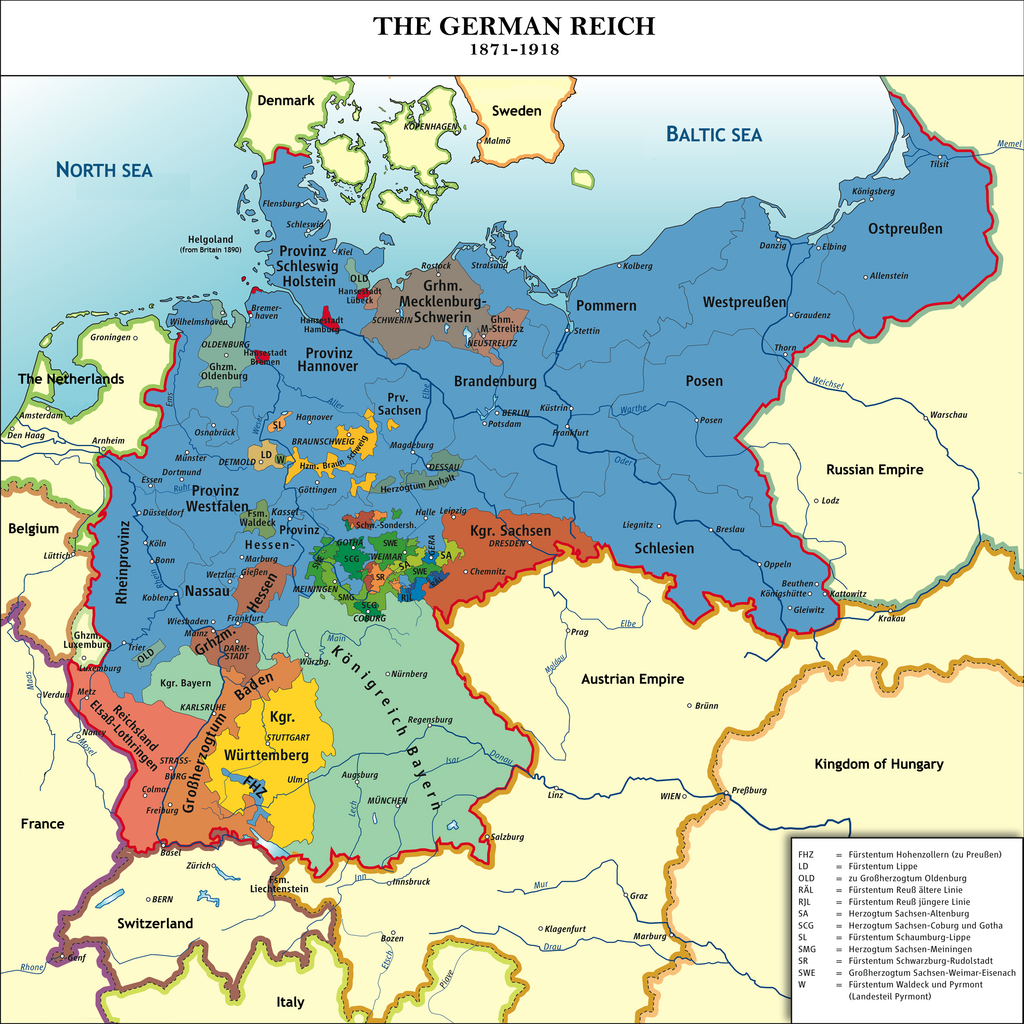
The Reich after the unification in 1871
The Wars of Unification or Schleswig-Holstein Question (1864) saw Prussia and Austria jointly defeating Denmark, gaining control of the duchies of Schleswig and Holstein, setting the stage for conflicts between Prussia and Austria and the Austro-Prussian War in 1866) or “Seven Weeks” War, saw Prussia decisively defeating Austria, which led to the dissolution of the German Confederation and exclusion of Austria from German affairs.
The Franco-Prussian War (1870-1871) was the final touch to this process, with Bismarck manipulating tensions with France to provoke a war, rallying southern German states to Prussia’s side. The war culminated in the defeat of France and the proclamation of the German Empire at the Palace of Versailles in 1871, with Wilhelm I of Prussia becoming Emperor.
With the emergence of a shared German identity and the decisive input of this statesman, paved the way for German unification under Prussian hegemony. The new German Empire becale overnight a major European power and marked a significant turning point in European history, mirrored in the south by the unification if Italy prior and loss if influence of Austrian, which became the Austro-Hungarian Empire.
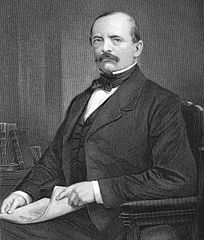 Otto Von Bismarck was a towering figure in European politics in the 19th century. Born on April 1, 1815 into an aristocratic Prussian family he studied law and pursued a career in the Prussian civil service, initially serving as a diplomat. He entered politics in the 1840s, representing Prussia in the German Confederation. His tenure as Prime Minister of Prussia (1862-1890) was marked by his commitment to the idea of a united Germany under Prussian leadership. Through a combination of diplomacy and warfare, Bismarck orchestrated the unification of Germany under Prussian hegemony. He famously used the phrase “blood and iron” to describe his approach, indicating the importance of military force alongside diplomacy. He skillfully manipulated diplomatic tensions and engaged in wars, such as the Austro-Prussian War (1866) and the Franco-Prussian War (1870-1871), to weaken Prussia’s rivals and strengthen its position. As Chancellor of the German Empire under Kaiser Wilhelm I he sought to consolidate the new empire’s power and maintain stability in Europe. He implemented a series of domestic policies known as the “Kulturkampf” to suppress the influence of the Catholic Church and the Social Democratic Party. He also pursued a complex system of alliances to isolate France and prevent the emergence of any threats to Germany’s security, culminating in the creation of the Triple Alliance with Austria-Hungary and Italy.
Otto Von Bismarck was a towering figure in European politics in the 19th century. Born on April 1, 1815 into an aristocratic Prussian family he studied law and pursued a career in the Prussian civil service, initially serving as a diplomat. He entered politics in the 1840s, representing Prussia in the German Confederation. His tenure as Prime Minister of Prussia (1862-1890) was marked by his commitment to the idea of a united Germany under Prussian leadership. Through a combination of diplomacy and warfare, Bismarck orchestrated the unification of Germany under Prussian hegemony. He famously used the phrase “blood and iron” to describe his approach, indicating the importance of military force alongside diplomacy. He skillfully manipulated diplomatic tensions and engaged in wars, such as the Austro-Prussian War (1866) and the Franco-Prussian War (1870-1871), to weaken Prussia’s rivals and strengthen its position. As Chancellor of the German Empire under Kaiser Wilhelm I he sought to consolidate the new empire’s power and maintain stability in Europe. He implemented a series of domestic policies known as the “Kulturkampf” to suppress the influence of the Catholic Church and the Social Democratic Party. He also pursued a complex system of alliances to isolate France and prevent the emergence of any threats to Germany’s security, culminating in the creation of the Triple Alliance with Austria-Hungary and Italy.
However his authoritarian governing style and conflicts with Wilhelm II led to his resignation in 1890. He retired to private life but remained influential in German politics until his death in 1898. His legacy as the “Iron Chancellor” and the “Founder of the German Empire” endures, with his diplomatic and political strategies shaping European history for decades to come.
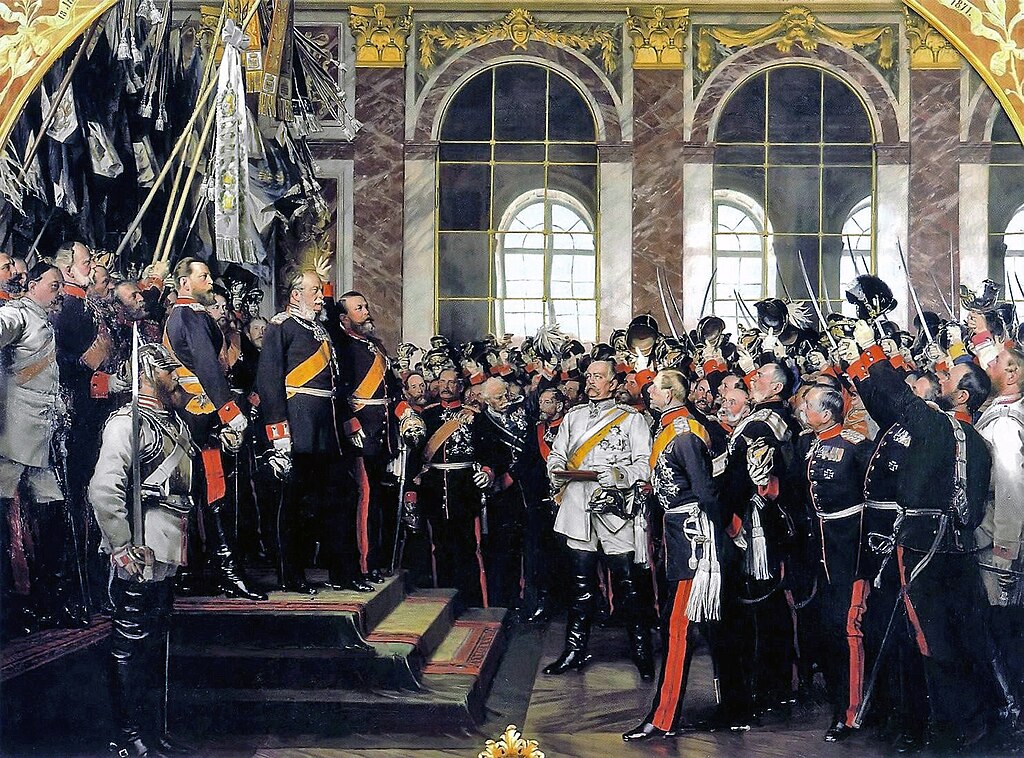
The unification ceremony and proclamation in Versailles by 18 January 1871.
The Prussian Navy in 1860
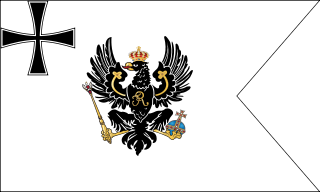 The Prussian Navy, known as the Preußische Marine or Prussian Naval Forces, was a relatively small and fledgling maritime force compared to the powerful navies of other European nations like Britain and France.
The Prussian Navy, known as the Preußische Marine or Prussian Naval Forces, was a relatively small and fledgling maritime force compared to the powerful navies of other European nations like Britain and France.
The Prussian Navy was created in 1701 from the former Brandenburg Navy after the dissolution of Brandenburg-Prussia and personal union under the House of Hohenzollern and Frederick I from Duke to King. The Prussian Navy was actiive in many wars and merchant navy in the 18th-19th centuries, but the was Kingdom’s poor child as all efforts went to the Prussian Army. The Prussian Navy was dissolved in 1867 as Prussia joined the North German Confederation, its ships absorbed into the North German Federal Navy.
The focus of Prussia’s military efforts during this period was primarily on its army, which played a central role in the wars of German unification under Otto von Bismarck’s leadership.
The Prussian Navy’s fleet consisted mainly of small warships, coastal defense vessels, and a limited number of frigates and steam-powered ships. Its primary function was to protect Prussia’s coastline and support its maritime interests in the Baltic Sea.
During this time, Prussia did not possess a significant blue-water navy capable of engaging in large-scale naval operations or power projection beyond its immediate coastal waters. Instead, the emphasis was on coastal defense, patrolling territorial waters, and protecting trade routes.
However, the 1860s marked the beginning of a period of naval expansion and modernization in Prussia, driven by the broader trend of European naval arms race and the recognition of the importance of sea power in international affairs. This laid the groundwork for the eventual development of the German Imperial Navy following the unification of Germany in 1871.
It’s important to note that while the Prussian Navy of 1860 was relatively modest, its role in safeguarding Prussia’s maritime interests and contributing to the broader military capabilities of the Prussian state cannot be overlooked, especially considering the geopolitical context of the time.
The German State and the German Navy were creations of the second half of the 19th century, In 1860 Germany was still a patchwork of independent states. Only Prussia, the most powerful of these, had a navy, and even that was being created from virtually nothing. In 1864 Prussia, allied with Hapsburg Austria, the power that still dominated Germany, defeated Denmark in Schleswig-Holstein. In this war the Prussian Navy plaved a small part in the Battle of Heligoland between Danish and Austrian steam frigates. Two years later Prussia defeated Austria at Sadowa in a ‘six weeks war’ in which her fleet was not engaged. The removal of Austrian influence left Prussia free to found the North German Federation, to which her fleet was officially transterred in 1867.
STRENGTH OF THE PRUSSIAN FLEET 1860
Steam corvettes: Arcona, Gazelle
Steam paddle frigates: Barbarossa (ex-Cunarder Britannia. Hulked “1865, torpedoed in experiments 1880); Danzig launched 185] at Danzig, burnt out 1869); Loreley (launched 1859 at Danzig, sold 1896)
Sailing frigates: Gefion (ex-Eckernforde, ex-Gefion, captured from the _Danes when she grounded in 1848, broken up 1891), Thetis. built for the Royal Navy in 1846, exchanged with another vessel for two steam gunboats at the time of the Crimean War, broken up 1895)
Sailing corvettes: Amazone (built 1843 and lost in a storm 1861)
Armed steam yacht: Grille (built in France 1857, later rebuilt, broken up 1920)
Transport: Mercur (built 1847, broken up 1861)
Schooners: Hela, frrauenlob {built 1853/5, scrapped in 1871, lost in 1860)
Steam gunboats: The first of the Jager and Chamdleon class were coming into service
Rowing and sailing gunboats: 42
Unarmed steamer: Royal Viktoria
TOTAL: Approximately 55 vessels mounting about 270 guns in all.
- Prinz Adalbert (1864)
- Arminius (1864)
- Friedrich Carl (1867)
- Kronprinz (1867)
- K.Whilhelm (1868)
- Arcona class Frigates (1858)
- Nymphe class Frigates (1863)
- Augusta class Frigates (1864)
- Jäger class gunboats (1860)
- Chamaleon class gunboats (1860)
The new Imperial German Navy 1870-1890
THE ORIGINS OF THE IMPERIAL NAVY
An attempt had been made to set up a Federal German Navy in the first flush of enthusiasm for the 1848 revolutions. It was not a success, most of the men had to be recruited from abroad, and the ships purchased for it were sold by auction in 1853. Prussia had had a handful of rowing gunboats and schooners for coastal defence since the 1820s, but it was not until the early 1850s that it was decided to set up a navy, under Prince Heinrich of Prussia, large enough to make a real contribution to the defence of German waters. From the start the emphasis was on training: the new navy rapidly acquired a reputation for professionalism and seamanship which the German Navy never lost, and this was the real reason why it so quickly became a threat. Known as the Prussian Navy until 1866, and the Navy of the North German Federation before 1871, it is more convenient to use the blanket term German Navy from now on.
THE FIRST MODERN WARSHIPS
In 1859 the new navy began to receive its first steam corvettes and steam gunboats and it is from this point that the list below begins, rather than 1860. It was not until the mid 1860s that the fleet began to purchase armoured vessels, at first from foreign yards, the first German-built battleships being laid down in 1868. The last foreignbuilt ironclads were ordered in 1872, and the last major warship built abroad was the Zieten of 1876. After that, apart from a few torpedo -essels, Germany relied entirely on her own shipbuilding resources. New naval dockyards were set up at Wilhelmshaven and Kiel, and .msiderable use was also made of private shipyards. A shaky start was ade with the Hansa, and for a while building speeds were slow. F vreign industry (mainly British) had to be relied on for heavy castings nd the best engines, but German yards soon proved to be competent builders of all types or warships. Before the 19th century was over, one yard, Schichau at Stettin, had scored a great export success with its torpedo boat and destroyer designs, proving itself the equal of the British builders Thornycroft and Yarrow and the French Le Normand vard. By the mid 1870s the then head of the German Navy, General von Stosch, could feel he was succeeding in his aim to produce a good navy of the second rank, adequate for coast defence and covering Germany’s overseas commitments, with sufficient numbers of ironclads, curising ships and gunboats. x During the late 1870s and 1880s the emphasis began to shift.
The few new head of the navy, General von Caprivi, was particularly keen on new underwater weapons, the mine and torpedo, and it is from this time that Germany began to build up formidable and well-trained is torpedo flotillas and also began building mines which in 1914 proved to be the best in the world. Out of the interest in torpedo craft came the 2 world’s first genuine light cruisers, but the construction of larger 1. vessels was neglected, and only a few small coastal defence battelships were completed.
CREATION OF THE IMPERIAL NAVY:
In 1870 Bismarck successfully provoked France into declaring war, and the army of the German Federation broke the forces of Napoleon Il]. The overwhelming superiority of the French fleet had meant that the German ships, blockaded in thier ports, played little part in the struggle which enabled the King of Prussia to be proclaimed Kaiser of the German Reich at Versailles in 1871.
With Germany united it was inevitable that the new Imperial Navy should grow, more particularly as Germany was becoming the most powerful industrial nation in Europe. Germany soon had a naval force which was the equal of those of the traditional naval powers of Northern Europe, Denmark, Holland and Sweden. It was not until the 1890s that Kaiser Wilhelm II and Admiral Tirpitz, combined with the evergrowing industrial strength of Germany, created a situation in which the Imperial Navy attempted to equal the largest navies in existence. By 1905 the German Navy had surpassed the French in size and was rivalling the American Navy as the second largest in the world, while its ambitious plans for expansion made it a potent threat to even the Royal Navy.
THE ‘RISK’ THEORY:
This was a deliberate threat, as Tirpitz and his allies were quite plainly aiming to challenge Britain, even before the Navy Law of 1898 set out the blueprint for expansion. This would have seemed a ridiculous challenge, even ten years before, when the German Navy, though well-trained and efficient, was still very definitely of the second rank. It was the phenomenal industrial growth of Germany, allied to the fact that the navy was one of the few genuinely national forces in a newly united country, that created the economic, financial and political support to make the challenge possible. A love-hate relationship with Engiand, with the clement of hate gradually increasing, provided an atmosphere in which ‘Tirpitz could win general support for his ‘Risk’ theory. That is, the German Navy, it itcould never actually achieve the strength of the Roval Navy, would be able to do enough damage in watime to destroy the Roval Navy’s superiority over its traditional Waly, particularly France and Russia. England could never risk this, “8 would theretare be blackmailed into supporting Germany on the Continent, aid giving her concessions overseas. However, this ploy recoiled on the blackmailer: by 1906 England, than give in to the threat, had reached an informal understanding with her old enemy France, and was about to do the same with Kessi:. In any case, the British shipbuilding industry was far stronger and in Most respects more efficient than the German, and provided the 3. tush people felt the threat was large enough to warrant the necessary expenditure, could easily outbuild Germany, or any other rival. The true measure of Tirpitz’s policy would be seen in 1914, when Britain joined France and Russia against Germany, leaving it supported only by the weakened Austrian Empire.
STRENGHT
- Ironclad Hansa (1872)
- G.Kurfürst class (1873)
- Kaiser class (1874)
- Sachsen class (1877)
- Ironclad Oldenburg (1884)
- Ariadne class CVT (1871)
- Leipzig class CVT (1875)
- Bismarck class CVT (1877)
- Carola class CVT (1880)
- Corvette Nixe (1885)
- Corvette Charlotte (1885)
- Schwalbe class Cruisers (1887)
- Bussard class (1890)
- Aviso Zieten (1876)
- Blitz class Avisos (1882)
- Aviso Greif (1886)
- Wacht class Avisos (1887)
- Meteor class Avisos (1890)
- Albatross class GBT (1871)
- Cyclop GBT (1874)
- Otter GBT (1877)
- Wolf class GBT (1878)
- Habitch class GBT (1879)
- Hay GBT (1881)
- Eber GBT (1881)
- Rhein class Monitors (1872)
- Wespe class Monitors (1876)
- Brummer class Arm.Steamers (1884)
THE TIRPITZ ERA
The 1890s saw a new phase, with Kaiser Wilhelm II coming to the 71S throne, and an increasing public interest in naval expansion. This S$ culminated in Tirpitz’s appointment as Secretary of State for the Navy, Ht} in 1897. A year later the First Naval Law provided for a navy of 19 battleships, 8 coastal defence ships, and 12 heavy and 30 light cruisers c S by 1903. Two years later a new programme was laid down, to build a TC navy of 38 battleships, 14 heavy cruisers, 34 light cruisers and 96 destroyers by 1920. British reactions heightened the atmosphere of 8 tension and then came the blow which temporarily halted the German Construction programme of major ships. The Dreadnought and Invincible presented completely new ideas regarding the design of capital ships, so that more new designs had to be produced to rival them. By any standards the growth of the German Navy from nothing to the second in the world in under 50 years was an impressive achievement, the development spanned less than one lifetime, indeed there Was one young German who wished to become a naval officer in the Middle of the last century, could not do so in his own country, and so joined the Royal Navy. In 1914, ironically, Prince Louis of Battenburg — was First Sea Lord when the First World War broke out.
THE GROWTH OF THE GERMAN NAVY
⚙ Growth by types and key eras |
||||||||||
| Types | 1860 | 1865 | 1875 | 1880 | 1885 | 1890 | 1895 | 1900 | 1905 | |
| Battleships | – | – | 5 | 5 | 9 | 12 | 12 | 21 | 24 | 29 |
| Heavy cruisers | 2 | 3 | 5 | 5 | 11 | 9 | 6 | 2 | 6 | 9 |
| Light cruisers | 1 | 3 | 4 | 6 | 7 | 12 | 20 | 25 | 26 | 34 |
| Torpedo craft | – | – | – | 6 | 7 | 2 | 77 | 99 | 92 | 124 |
In the above table battleships include coast defence battleships and ironclads of all kinds, heavy cruisers include all the larger cruising ships, and light cruisers the smaller ones. Gunboats and other light vessels are not included.
ARMAMENT
Although some of the first vessels had SB or RML guns, the German Navy adopted Krupp BL guns at an early date, and the vast majority of the ships listed below had BL guns of one kind or another. The standard German QF anti-torpedo boat gun in the 1880s and 1890s was the five-barrelled revolving Hotchkiss 37mm. The approximate Imperial measure equivalents of the calibres of guns and torpedo tubes in general use with the German Navy are as follows:
280mm = 11 in; 260mm = 10in; 240mm = 9.4in; 210mm = 8.2in; 170mm = 6.7in; 150mm = 5.9in; 125mm = 5in; 120 mm = 4.7in; 105mm = 4. lin; 88mm = 3.5in; 87mm = 3.5in; 50mm = 2in; 37mm = 1.5in. Torpedo tubes:350mm = 14in; 450mm = 18in.
In 1890, the German Navy, known as the Kaiserliche Marine, was in a period of rapid expansion and modernization under the direction of Kaiser Wilhelm II and Admiral Alfred von Tirpitz. This expansion was part of Wilhelm II’s vision to establish Germany as a global power and to challenge the naval supremacy of Britain.
At that time, the German Navy was transitioning from a coastal defense force to a more ocean-going fleet. The construction of battleships, cruisers, and other vessels was prioritized, and Germany aimed to build a navy capable of competing with the Royal Navy.

S.M. Deutschland (1874 Kaiser class, modernized) in Port Arthur, circa 1900
One significant development during this period was the launch of the first German armored battleship, the SMS Sachsen, in 1877. This marked the beginning of Germany’s efforts to build a powerful battleship fleet. The Kaiserliche Marine also invested in cruisers for reconnaissance and commerce raiding, as well as torpedo boats and submarines.
By 1890, the German Navy had become one of the most formidable in Europe, although it still lagged behind the Royal Navy in terms of size and strength. However, its rapid growth and modernization efforts would soon make it a significant rival to Britain’s naval dominance, leading to tensions that contributed to the arms race leading up to World War I.
The German Navy in 1890
There were still a number of “legacy” vessels dating back from the 1870s:
–The turret ship Arminius* (1863). She was modernized in 1870 as harbour defence ship and 1881 as instruction ship for engineers, but by 1892 she becale an icebreaker in Kiel until 1901.
–Ironclad Friedrich Carl**: The 1866 ironclad was still used as harbour defence ship in 1890 but by 1892 she was relegated as torpedo school ship and by 1902 renamed Neptun. BU 1906.
–Ironclad Kronprinz*: Launched 1867, also used as harbour/coastal defence ship in 1890. By 1901 she was hulked, used as machinery hulk until BU in 1921.
–Ironclad König Wilhelm*: Launched 1868, she was redbuilt comprehensively in 1878-82 and served in 1890 as coastal defence ship. From 1904 Harbour ship, then schoolship until BU 1921.
–Ironclad Hansa***:: A very small ship, not modernized and hulked in 1888.
–Grosser Kurfürst class ironclads (1874)***: Kurfürst was no longer listed in 1890 as she sank after a collision in 1878. Both Friedrich der Grosse and Preussen were hulked 1906.
–Kaiser class ironclads (1874)*: Last masted ironclads of the Germany Navy. Kaiser and Deutschland were modernized in 1882 and 1897, still arounbd as harbour ships under new names in 1907: Uranus and Jupiter. Both BU 1920 and 1909 respectively.
–Sachsen class Ironclads*** (1877): The first German modern, steam only ironclads, with six 26cm barbette guns. See below.
–Oldenburg Ironclad*** (1884): Last “classic” ironclad, recent in 1890 as she was commissioned in 1886. See below.
–Siegfried class coast defence battleships*** (1889): Not treated here. Siegfried, lead vessel of eight ships named after Nordic mythology, entered service in April 1890 so the whole class escaped this topic. But construction was decided in 1887. The last was completed in 1896. See the WWI section for more.
*Britsh Built **French Built ***German built
 SMS Hansa (1875)
SMS Hansa (1875)

SMS Hansa was an ironclad corvette built in 1868–1875, and first ironclad built in Germany. She was named after the Hanseatic League, laid down in 1868 as a corvette, modified and launched in October 1872 as an ironclad, commissioned into the Kaiserliche Marine in May 1875. She was not at first a high seas ship but was tailored for coastal bombardment, armed with eight 21 cm (8.3 in) guns in a central battery. She took part in fleet exercises in the 1875 training year, made a major overseas cruise to Central and South America until 1880, protected German nationals during the Pacific war. In 1884, her iron hull was found badly corroded, so she was removed from active duty and used as auxiliary, a guard ship in Kiel, machinery crew trainer, but she was in such poor condition by 1888 as to be stricken, demoted as barracks ship in Kiel, then Mönkeberg in 1905, training personnel until 1906 and sold for BU. Not a brilliant career but she at least gave Kaiserliche Werft, Danzig a first taste of ironclad construction.
 Grosser Kurfurst class (1875)
Grosser Kurfurst class (1875)
(to come)
 Kaiser class (1874)
Kaiser class (1874)
(to come)
 Sachsen class (1877)
Sachsen class (1877)

 SMS Oldenburg (1884)
SMS Oldenburg (1884)

(to come)
Rhein class (1872): By 1872 two armoured Monitors were built, the Rhein class, intended for the Rhein and to complete fortifications.
Wespe Class (1876): In 1874, the German Empire ordered a serie of 11 armoured steamers. These 1139 tons ships were shalow draught gunboats, coastal vessels similar the British “Rendel Gunboats”. They could be grounded on sandbanks to be used as fixed batteries. Armament was limited to a single 12-in (30.5 cm) gun in an open barbette, although surrounded by a 8-in thick breastwork, same on the belt. Poor seaboats, they were seldom used and rather kept in reserve, rearmed at some point but discarded in 1909 to 1911. Viper is known to have been used as a barge until the 1960s.
Brummer class (1884): Another takeoff of the concept, lighter at 914 tonnes, they were able to reach 15 knots thanks to their compound 2000 shp steam engine, and carried a single 21 cm guns and 87, 37 mm QF guns plus TTs. Brummer and Bremse launched in 1884 had a 6.5 in (160 mm) bulkhead. good seaboat, at the end of their career, the first became a gunnery school ship then fishery protection vessel, weapons and machinery school ship, BU in 1922 and her sister was used as an oil barge, BU in 1910 and reused in civilian service for many more years.
⚠ Note: This page is in writing. Completion expected later in 2024.
❯❯❯❯❯❯❯❯❯❯❯
Read More
Books
Clowes, William Laird; Markham, Clements; Mahan, Alfred Thayer; Wilson, Herbert Wrigley & Roosevelt, Theodore (1903). The Royal Navy
Gröner, Erich (1990). German Warships: 1815–1945. Vol. I: Major Surface Vessels. Naval Institute Press
Hildebrand, Hans H.; Röhr, Albert & Steinmetz, Hans-Otto (1993). Die Deutschen Kriegsschiffe
Gardiner, Robert; Chesneau, Roger & Kolesnik, Eugene M. (eds.). Conway’s All the World’s Fighting Ships 1860–1905
Marley, David (2008). Wars of the Americas: A Chronology of Armed Conflict in the Western Hemisphere. Santa Barbara
Nottelmann, Dirk (2020). “The Development of the Small Cruiser in the Imperial German Navy”. Warship 2020. Osprey
Nunez, Severo Gómez (1899). The Spanish–American War: Blockades and Coast Defense. DC: Washington, Govt. Print.
“Schurz”. Dictionary of American Naval Fighting Ships. Navy Department
Sondhaus, Lawrence (1997). Preparing for Weltpolitik: German Sea Power Before the Tirpitz Era.
Vego, Milan N. (1996). Austro-Hungarian Naval Policy, 1904–14. Frank Cass Publishers.

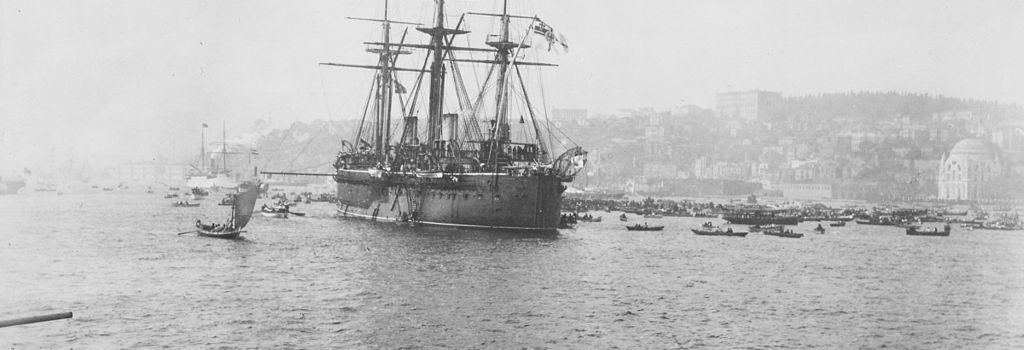
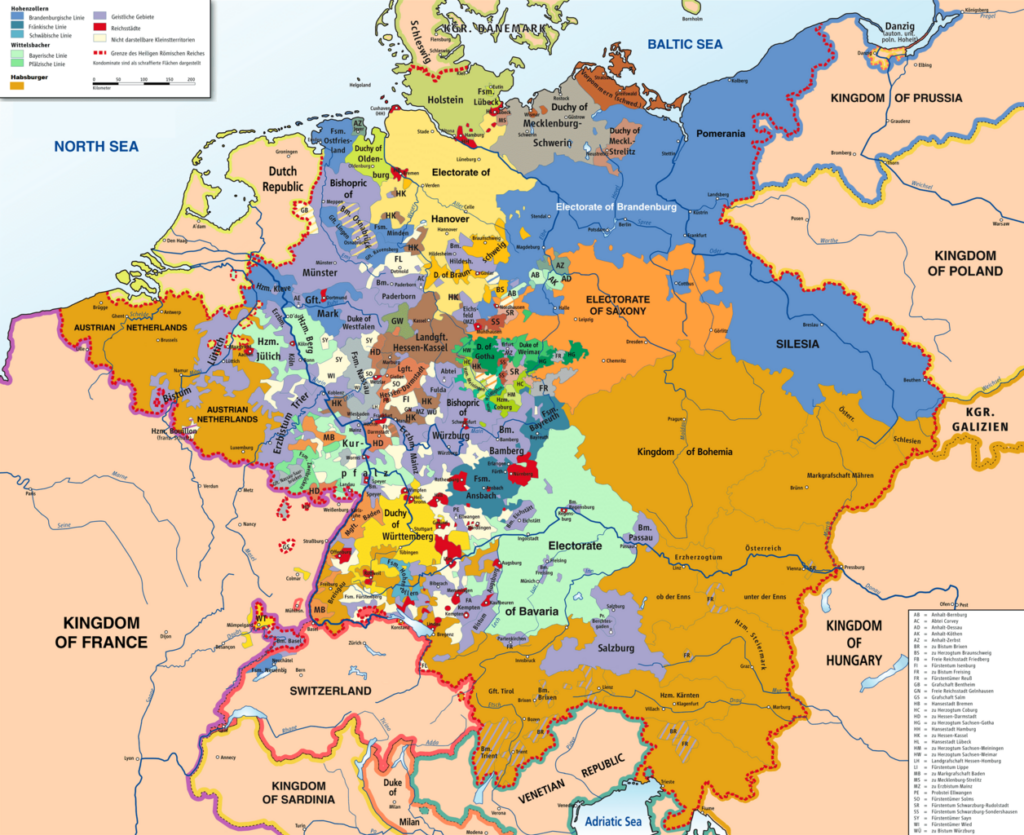
 Latest Facebook Entry -
Latest Facebook Entry -  X(Tweeter) Naval Encyclopedia's deck archive
X(Tweeter) Naval Encyclopedia's deck archive Instagram (@navalencyc)
Instagram (@navalencyc)





 French Navy
French Navy Royal Navy
Royal Navy Russian Navy
Russian Navy Armada Espanola
Armada Espanola Austrian Navy
Austrian Navy K.u.K. Kriegsmarine
K.u.K. Kriegsmarine Dansk Marine
Dansk Marine Nautiko Hellenon
Nautiko Hellenon Koninklije Marine 1870
Koninklije Marine 1870 Marinha do Brasil
Marinha do Brasil Osmanlı Donanması
Osmanlı Donanması Marina Do Peru
Marina Do Peru Marinha do Portugal
Marinha do Portugal Regia Marina 1870
Regia Marina 1870 Nihhon Kaigun 1870
Nihhon Kaigun 1870 Preußische Marine 1870
Preußische Marine 1870 Russkiy Flot 1870
Russkiy Flot 1870 Svenska marinen
Svenska marinen Søværnet
Søværnet Union Navy
Union Navy Confederate Navy
Confederate Navy Armada de Argentina
Armada de Argentina Imperial Chinese Navy
Imperial Chinese Navy Marinha do Portugal
Marinha do Portugal Mexico
Mexico Kaiserliche Marine
Kaiserliche Marine 1898 US Navy
1898 US Navy Sovietskiy Flot
Sovietskiy Flot Royal Canadian Navy
Royal Canadian Navy Royal Australian Navy
Royal Australian Navy RNZN Fleet
RNZN Fleet Chinese Navy 1937
Chinese Navy 1937 Kriegsmarine
Kriegsmarine Chilean Navy
Chilean Navy Danish Navy
Danish Navy Finnish Navy
Finnish Navy Hellenic Navy
Hellenic Navy Polish Navy
Polish Navy Romanian Navy
Romanian Navy Turkish Navy
Turkish Navy Royal Yugoslav Navy
Royal Yugoslav Navy Royal Thai Navy
Royal Thai Navy Minor Navies
Minor Navies Albania
Albania Austria
Austria Belgium
Belgium Columbia
Columbia Costa Rica
Costa Rica Cuba
Cuba Czechoslovakia
Czechoslovakia Dominican Republic
Dominican Republic Haiti
Haiti Hungary
Hungary Honduras
Honduras Estonia
Estonia Iceland
Iceland Eire
Eire Equador
Equador Iran
Iran Iraq
Iraq Latvia
Latvia Liberia
Liberia Lithuania
Lithuania Mandchukuo
Mandchukuo Morocco
Morocco Nicaragua
Nicaragua Persia
Persia San Salvador
San Salvador Sarawak
Sarawak Uruguay
Uruguay Venezuela
Venezuela Zanzibar
Zanzibar Warsaw Pact Navies
Warsaw Pact Navies Bulgaria
Bulgaria Hungary
Hungary

 Bundesmarine
Bundesmarine Dutch Navy
Dutch Navy Hellenic Navy
Hellenic Navy Marina Militare
Marina Militare Yugoslav Navy
Yugoslav Navy Chinese Navy
Chinese Navy Indian Navy
Indian Navy Indonesian Navy
Indonesian Navy JMSDF
JMSDF North Korean Navy
North Korean Navy Pakistani Navy
Pakistani Navy Philippines Navy
Philippines Navy ROKN
ROKN Rep. of Singapore Navy
Rep. of Singapore Navy Taiwanese Navy
Taiwanese Navy IDF Navy
IDF Navy Saudi Navy
Saudi Navy Royal New Zealand Navy
Royal New Zealand Navy Egyptian Navy
Egyptian Navy South African Navy
South African Navy






























 Ukrainian Navy
Ukrainian Navy dbodesign
dbodesign